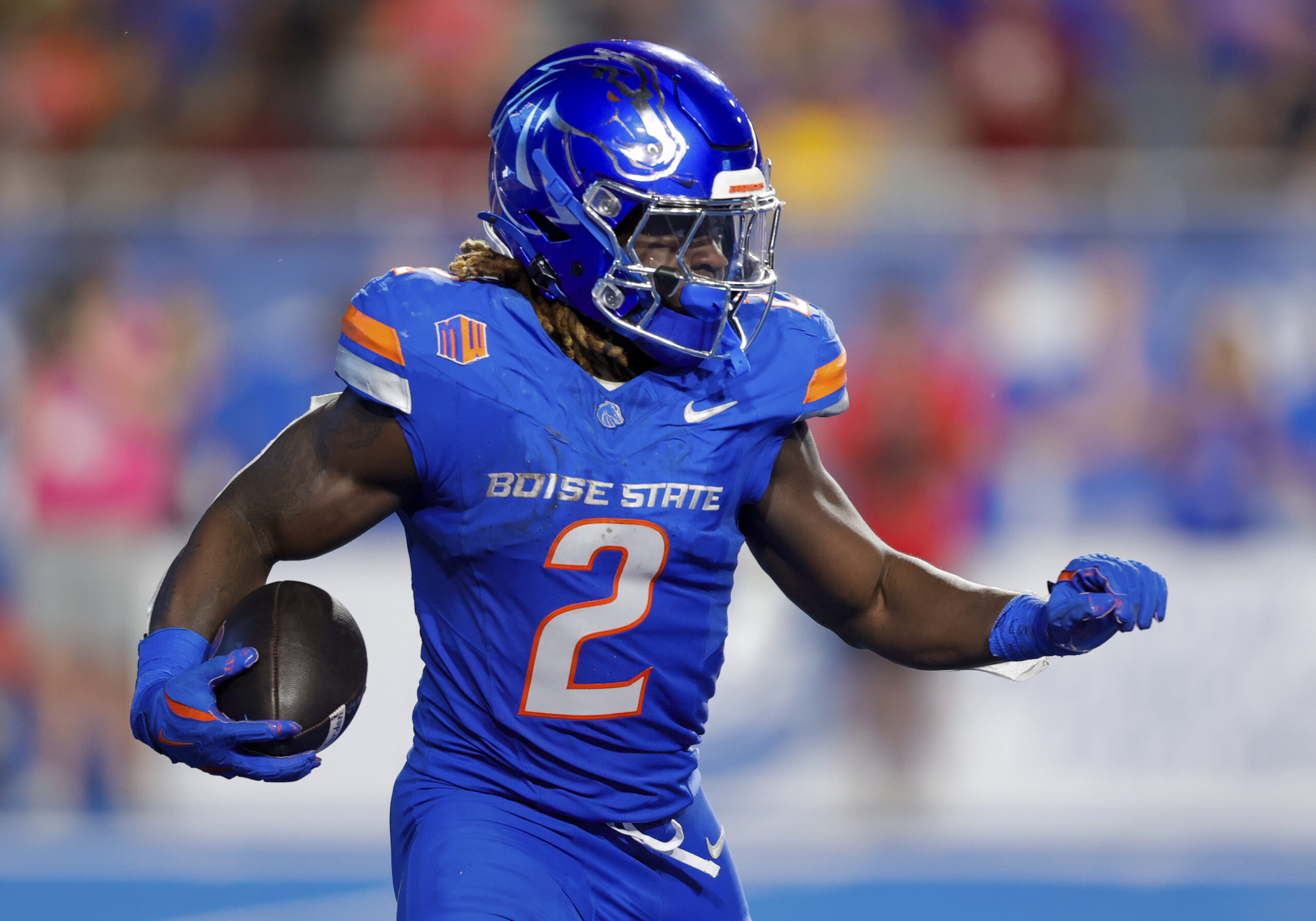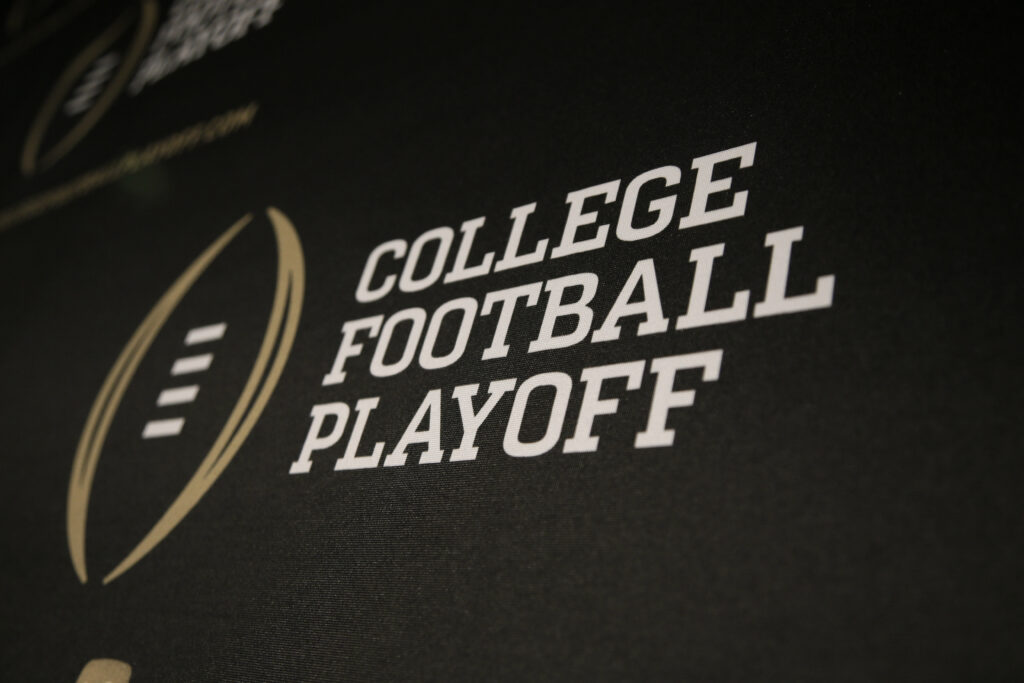Expansion of the College Football Playoff is arguably the greatest competitive change in the sport’s history — more significant than the move from the Bowl Championship Series to the four-team CFP a decade ago. Each week, the Hotline will dive into the 12-team CFP race with a look at the frontrunners, bubble teams and key developments across the landscape.
The Mountain West steps into the national spotlight this week with Boise State visiting UNLV on Friday night. The matchup has playoff implications for both teams, but not equivalent implications. There’s arguably more on the line for the Broncos because their seed ceiling is higher.
The expanded College Football Playoff assigns the top-four seeds to the highest-ranked conference champions. The presumption all along has been that the ACC, Big 12, Big Ten and SEC winners would receive those coveted spots — and the accompanying bye into the quarterfinals.
 But nothing in the selection process guarantees the top seeds to the Power Four champions, which opens a path for Boise State (5-1) to potentially finish with a higher ranking than the Big 12 champion.
But nothing in the selection process guarantees the top seeds to the Power Four champions, which opens a path for Boise State (5-1) to potentially finish with a higher ranking than the Big 12 champion.
For that upset of upsets to unfold in their favor, the Broncos need:
— To run the table and finish as a 12-1 Mountain West champion with their only loss coming by three points at Oregon. (Because optics matter in the process, it would help their cause if tailback Ashton Jeanty maintains his position as a Heisman Trophy frontrunner.)
— Oregon to either win the Big Ten title or finish as a one-loss runner up to Ohio State, thus ensuring that Boise State’s only defeat was the highest-quality loss possible.
— Texas Tech to win the Big 12 championship, giving the Broncos a potential advantage over the Red Raiders in a resume showdown on selection weekend.
How so? Weeks before Boise State walloped Washington State (in late September), Washington State thumped Texas Tech. Those two results could serve as a material point of comparison, in the Broncos’ favor, for the selection committee.
Now, if the Red Raiders don’t win the Big 12 — they are currently 3-1 in conference play, one game behind Brigham Young and Iowa State — the situation becomes substantially more muddled.
And in a system designed to protect the Power Four, muddled situations are suboptimal for the Group of Five.
It’s difficult to envision one-loss Boise State being ranked higher than an undefeated or one-loss Big 12 champion because of brand bias and the potential disparity in schedule strength.
But if the Big 12 winner has two losses and the Broncos finish with one (at Oregon), their outlook for claiming a top-four seed would improve exponentially.
The process begins Friday.
To the projections …
Automatic bids
The five highest-ranked conference champions will receive automatic bids to the CFP, with the top four earning opening-round byes. The best team from the Group of Five will be seeded according to its ranking.
No. 1 Georgia (SEC champion). The Dawgs have played three A-level games (Clemson, Alabama and Texas) and looked like the best team in the country — not a perfect team, but the best team — in 10 of them. Not bad. Not bad at all.
No. 2 Oregon (Big Ten champion). The Ducks seem destined for a rematch against Ohio State for the Big Ten championship in Indianapolis. For now, our forecast favors Oregon.
No. 3 Clemson (ACC champion). A more complete team than Miami and getting better by the week.
No. 4 Brigham Young (Big 12 champion). The five Big 12 teams left on BYU’s schedule have a combined record of 6-14 in conference play. It will take two upsets to keep the Cougars out of the title game.
No. 12 Boise State (Group of Five). Beyond Boise State and UNLV, the top contenders for this spot are Memphis and two service academies: Army and Navy are undefeated, and it’s glorious.
At-large qualifiers
The seven highest-ranked non-champions will receive at-large bids. There is no limit to the number of at-large teams from a particular conference.
ACC: Miami. Any one-loss ACC runner up will contend for one of the precious at-large berths, no matter how many down-to-the-wire games it plays.
Big 12: none. There are too many games remaining for the Big 12 to produce a one-loss runner up. The conference’s eat-your-own instincts are simply off the charts.
Big Ten: Ohio State, Penn State and Indiana. The Hoosiers are for real, but can they keep winning without injured quarterback Kurtis Rourke (thumb)? And will the committee account for his absence when evaluating Indiana?
SEC: Tennessee and Texas. Imagine the uproar at ESPN if the SEC only gets two at-large bids.
Independent: Notre Dame. It’s often lost in the media narrative, but the Irish will play a vital role in the distribution of at-large bids. Contenders in the Power Four leagues need them to lose a second time.
Bubble teams
Expansion of the CFP has created room for a bubble comparable to the NCAA Tournament. The size of the bubble will ebb and flow throughout the season based on the latest results.
ACC: Pittsburgh and SMU. Don’t be surprised if the sizzling Mustangs end up in the ACC championship game.
Big 12: Iowa State and Kansas State. In our view, a two-loss Big 12 runner up will have only a slim chance to make the at-large field unless Notre Dame loses for a second time.
Big Ten: Illinois. If either of the Big Two conferences sends five teams into the CFP field, it will be the SEC. The Big Ten doesn’t have enough quality depth with USC and Washington floundering.
SEC: Alabama, LSU, Missouri and Texas A&M. The two-loss Crimson Tide cannot afford another defeat but is playing like a team that could lose multiple times down the stretch.
Projected matchups
The No. 5 through 12 seeds will play opening-round games on the campus of the higher seed, with the winners advancing to the quarterfinals on New Year’s Eve and New Year’s Day. (The semifinals are Jan. 9 and 10, followed by the championship game 10 days later.)
No. 8 Tennessee vs. No. 9 Notre Dame. We are not sure Knoxville would survive a home playoff game. Win or lose, the place could spontaneously combust at the final whistle. Winner plays No. 1 Georgia
No. 7 Penn State vs. No. 10 Miami. Carnage in the SEC has opened a path for the Nittany Lions to claim a No. 5-8 seed and host an opening-round game. Winner plays No. 2 Oregon
No. 6 Texas vs. No. 11 Indiana. The closer you look, the less impressive UT’s resume becomes. Michigan and Oklahoma just aren’t very good. Winner plays No. 3 Clemson
No. 5 Ohio State vs. No. 12 Boise State. The only chance for the Broncos to keep this close would come as a result of the Buckeyes looking (two games) ahead to their semifinal matchup against No. 1 Georgia. Winner plays No. 4 Brigham Young
Looking ahead: Week 9
Each week, the Hotline will examine a handful of games that figure to impact the CFP race for automatic and at-large bids.
(All times Pacific)
Boise State at UNLV (Friday, 7:30 p.m. on CBS Sports Network). The most significant Group of Five game of the season thus far, although the loser stands a good chance to force a rematch in the MW championship.
Notre Dame vs. Navy in East Rutherford, New Jersey (9 a.m. on CBS). An annual matchup that, for once, has CFP implications for both teams, and we should all bask in that reality.
LSU at Texas A&M (4:30 p.m. on ABC). Playoff elimination game for the vanquished, thereby raising the stakes for these one-loss teams.
*** Send suggestions, comments and tips (confidentiality guaranteed) to wilnerhotline@
*** Follow me on the social media platform X: @WilnerHotline
Related posts:
 Wilner Hotline – Best of the West: Washington soars, BYU slides and the Pac-12 dominates the Mountain West
Wilner Hotline – Best of the West: Washington soars, BYU slides and the Pac-12 dominates the Mountain West

(AP Photo/Marcio Jose Sanchez)
Business of Sports – Say what? Commissioner George Kliavkoff believes the Pac-12 will “catch” the Big Ten, SEC in media revenue. Allow us to explain
(AP Photo/Ralph Freso, File)
College Football Playoff expansion to begin in 2024 after Rose Bowl relents: Early start a boost for the Pac-12 The Pac-12 top 10: Key storylines from a wild week of staff hires, player departures, AD tweets
The Pac-12 top 10: Key storylines from a wild week of staff hires, player departures, AD tweets
Jon Wilner
Jon Wilner has been covering college sports for decades and is an AP top-25 football and basketball voter as well as a Heisman Trophy voter. He was named Beat Writer of the Year in 2013 by the Football Writers Association of America for his coverage of the Pac-12, won first place for feature writing in 2016 in the Associated Press Sports Editors writing contest and is a five-time APSE honoree.
